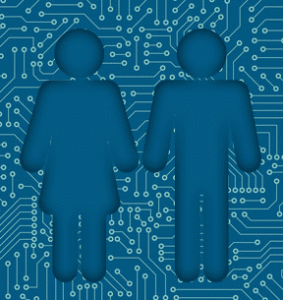- Calls to this hotline are currently being directed to Within Health or Eating Disorder Solutions
- Representatives are standing by 24/7 to help answer your questions
- All calls are confidential and HIPAA compliant
- There is no obligation or cost to call
- Eating Disorder Hope does not receive any commissions or fees dependent upon which provider you select
- Additional treatment providers are located on our directory or samhsa.gov
Removing the Stigma from Eating Disorders and Mental Health Issues
Contributor: Joanna Marino, PhD and Rebecca Hardin, PsyD of Potomac Behavioral Solutions

“Just try harder,”
“You need more willpower,”
“She just wants to be thin,”
“It’s not that serious, everyone does it.”
These are the unfortunate and often stigmatizing statements that are voiced when related to mental health conditions, especially disorders with a persistent course.
The stigma of mental health likely comes from several areas including misunderstanding of the less “tangible” or “biological” nature of mental health concerns and larger-scale cultural beliefs about those with mental health conditions.
The Divide Between Mental and Physical Health
The divide between mental and physical health conditions has long been debated. Thomas Szasz’s (1974) book, “The Myth of Mental Illness” is one of the most notable contributions to the controversy related to the validity of mental health diagnoses.
Szasz notes the difference between a “disease” process in the body and “mental illness” which he considered a “non-biological” judgment from society based on an individual’s behaviors and thoughts.
How Research Has Moved Treatment Forward

Indeed, NIH has focused on funding more research to support research aimed at identifying biological underpinnings of mental health concerns.
Disseminating research findings, especially related to the field’s increasing knowledge of biological relationships in mental health conditions, is likely the most effective way to reduce stigma related to mental health.
Insurance Companies Still Retain the Stigma
An unfortunate clinical demonstration of the continued stigma attached to mental health conditions is evident in the lack of insurance reimbursement received for eating disorder services.
The practice of limiting services to eating disorder patients continues in light of the strong research support that is developing related to the genetic and biological nature of eating disorders (EDs).
Studies on Eating Disorders

The field has also produced a large body of research suggesting alterations in brain pathways (Treasure & Campbell, 1994), brain structures (Craig, 2002; Phillips et al., 2003), neuropeptides (Morley & Blundell, 1988; Schwartz et al., 2000), and neurotransmitters (Blundell, 1984; Cooper, 1996; Jimerson et al, 1997; Kaye et al., 1988, 1990, 1991; Siegfried et al., 2004) that modulate feeding behaviors (i.e., restricting appetite), impulse control (possibly linked to binge eating and purging), and metabolism regulation.
Most telling is that many of these brain-based alterations have been shown to regulate after treatment and recovery from eating disorders (Kaye et al., 2004, Kaye, 2008).
Preventative Care Isn’t There
Even with the aforementioned research support, patients, families, and providers continue to face limited reimbursement for care, especially coverage for those who aren’t “suicidal” or “medically unstable.”
The continued limited coverage of treatment has led to several legal cases against insurance companies and the development of specialized case management and attorney firms (e.g., Kantor & Kantor) to aid patients in receiving reimbursement for much needed treatment.
Cultural Stereotypes Are Holding People Back from Treatment

Specifically, the DSM-5 enhanced the diagnostic criteria of eating disorders to increase awareness of significant differences in binge eating and overeating, to account for the inability of males and pre-menarche/peri-menopause females to meet the amenorrhea criteria of Anorexia Nervosa, to acknowledge the role food and eating have across cultures, and remove the arbitrary nature of BMI as related to ED behaviors.
The field of mental health continues to advance and continued focus on disseminating research will reduce the stigma tied to eating disorder and improve the clinical care via insurance reimbursement of much needed services. Continued education and advocacy in mental health will likely continue to help prioritize cultural understandings of mental health concerns.
References:
- Blundell, J. E. (1984). Serotonin and appetite. Neuropharmocology, 23, 1537-51.
- Cooper, S. J. (1996). Cholecystokinin modulation of serotonergic control of feeding behavior. Annuals of New York Academy of Science, 780, 213-222.
- Craig, A. D. (2002). How do you feel? Interoception: The sense of physiological condition of the body. National Reviews in Neuroscience, 3, 655-666.
- Jimerson, D. C., Wolfe, B. E., Metzger, E. D., Finkelstein, D. M., Cooper, T. B., …& Levine, J. M. (1997). Decreased serotonin function in bulimia nervosa. Archives of General Psychiatry, 54, 529-534.
- Kaye, W. H. (1998). Neurobiology of anorexia and bulimia nervosa Purdue Ingestive Behavior Research Center Symposium influences on eating and body weight over the lifespan: Children and adolescents. Physiological Behavior, 94, 121-135.
- Kaye, W. H., Gwirstman, H. E., George, D. T., Jimerson, D. C., & Ebert, M. H. (1988). CSF 5-HIAA concentrations in anorexia nervosa: Reduced values in underweight subjects normalize after weight gain. Biological Psychiatry, 23, 102-105.
- Kaye, W. H., Gwirstman, H. E., George, D. T., Jimerson, D. C., Ebert, M. H., … & Lake, C. R. (1990). Disturbances of noradrenergic systems in normal weight bulimia: Relationships to diet and menses. Biological Psychaitry, 27, 4-21.
- Kaye, W. H., Gwirstman, H. E., George, D. T., & Ebert, M. H. (1991). Altered serotonin activity in anorexia nervosa after long-term weight restoration. Does elevated cerebrospinal fluid 5-hydroxyindoleacetic acid level correlate with rigid and obsessive behavior? Archives of General Psychiatry, 48, 556-562.
- Kaye, W. H., Strober, M., & Jimerson, D. C. (2004). In Charney, D. S., & Nestler, E. J. (Eds.) The Neurobiology of Mental Illness (pp. 1112-1128). New York: Oxford Press.
- Lilenfeld, L. R., Kaye, W. H., Greeno, C. G., Merikangas, K. R., Plotnicov, K.,… & Nagy, L. (1998). A controlled family study of anorexia nervosa and builmia nervosa: Psychiatric disorders in first-degree relatives and effects of proband comorbidity. Archives of General Psychiatry, 55, 603-610.
- Morely, J. E., & Blundell, J. E. (1988). The neurobiological basis of eating disorders: Some formulations. Biological Psychiatry, 23, 53-78.
- Phillips, M. L., Drevets, W. C., Rauch, S. L., & Lane, R. (2003). Neurobiology of emotion perception I: The neural basis of normal emotion perception. Biological Psychiatry, 54, 504-514.
- Schwartz, M. W., Woods, S. C., Porte, D. Jr., Seely, R. J., & Baskin D. G. (2000). Central nervous system control of food intake. Nature, 404, 661-671.
- Siegfried, Z., Kanyas, K., Latzer, Y., Karni, O., Bloch, M., …& Berry, E. (2004). Association study of cannabinoid receptor genes (CNR1) alleles and anorexia nervosa: Differences between restricting and bingeing/purging subtypes. American Journal of Medicine and Genetics Part B (Neuropsychiatric Genes), 125B, 126-130.
- Strober, M., Freeman, R., Lampert, C., Diamond, J., & Kaye, W. (2000). Controlled family study of anorexia nervosa and bulimia nervosa: Evidence of shared liability and transmission of partial syndromes. American Journal of Psychiatry, 157, 393-401.
- Szasz, T. (1974). The myth of mental illness: Foundations of a theory of personal conduct. New York: Harper and Row.
- Treasure, J., & Campbell, I. (1994). The case for biology in the aetiology of anorexia nervosa. Psychological Medicine, 24, 3-8.
The opinions and views of our guest contributors are shared to provide a broad perspective of eating disorders. These are not necessarily the views of Eating Disorder Hope, but an effort to offer discussion of various issues by different concerned individuals.
Last Updated & Reviewed By: Jacquelyn Ekern, MS, LPC on February 12th, 2015
Published on EatingDisorderHope.com
